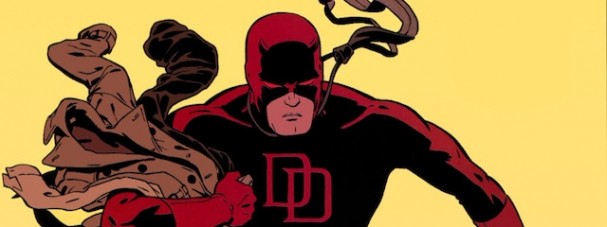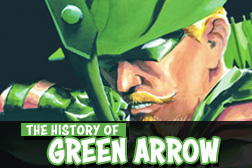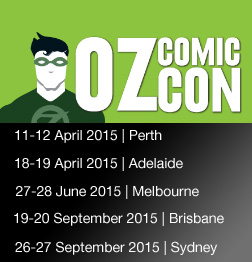Don’t have time for full reviews of comics? Then check out Graphic Bits: bite sized chunks of comic book goodness designed to get behind the panels and into your hearts.
This week (10 July 2013) take a look at the start of the next arc in Daredevil #28 (Marvel), find out what woman has power over death in East of West #4 (Image Comics), meet Barney Barton (again) in Hawkeye #12 (Marvel) and see how the post-apocalypse is faring in The True Lives of the Fabulous Killjoys #2 (Dark Horse). This is Graphic Bits.
The other half of this week’s Graphic Bits, featuring DC releases, can be found here.
Daredevil #28 – Marvel, Mark Waid (writer), Javier Rodriguez, Alvaro Lopez (artists). Rating: ★★★★½
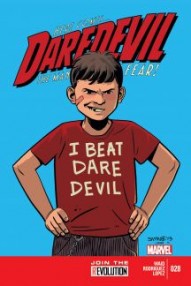 Matt Murdoch just can’t take a break. After concluding an essential Daredevil story last month, the culmination of what will go down as one of the best two years on the character in its distinguished history, Mark Waid appears to be presenting us with a brief interlude here. Yet like everything about this series to date, appearances are deceiving, and he’s actually setting us up for the next big thing. Following the defeat of an old foe, Matt turns his attention back to the ailing Foggy and their law firm. When a childhood bully, the very same that gave him the nickname ‘Daredevil’, turns up for help, Matt feel compelled to assist. It’s a cleverly laid out story that is also a great jumping-on point for new readers, taking us through the early days of Matt’s life before delivering a unique courtroom twist. Series colourist Rodriguez gives Chris Samnee a well-earned break from pencils, and slips effortlessly into this world. He begins mirroring Samnee to some extent, but the clean layouts and designs on a patrol montage, or a flashback to a previous Avengers fight, mark Rodriguez as a talented artist and one to watch in the near future. This book continues to be the high water mark of storytelling in the Marvel universe, and if this introduction is anything to go by, then the next two years are going to be another magic ride.
Matt Murdoch just can’t take a break. After concluding an essential Daredevil story last month, the culmination of what will go down as one of the best two years on the character in its distinguished history, Mark Waid appears to be presenting us with a brief interlude here. Yet like everything about this series to date, appearances are deceiving, and he’s actually setting us up for the next big thing. Following the defeat of an old foe, Matt turns his attention back to the ailing Foggy and their law firm. When a childhood bully, the very same that gave him the nickname ‘Daredevil’, turns up for help, Matt feel compelled to assist. It’s a cleverly laid out story that is also a great jumping-on point for new readers, taking us through the early days of Matt’s life before delivering a unique courtroom twist. Series colourist Rodriguez gives Chris Samnee a well-earned break from pencils, and slips effortlessly into this world. He begins mirroring Samnee to some extent, but the clean layouts and designs on a patrol montage, or a flashback to a previous Avengers fight, mark Rodriguez as a talented artist and one to watch in the near future. This book continues to be the high water mark of storytelling in the Marvel universe, and if this introduction is anything to go by, then the next two years are going to be another magic ride.
East of West #4 – Image Comics, Jonathan Hickman (writer), Nick Dragotta (artist). Rating: ★★★★
 One thing is evident by the fourth issue of one of 2013’s best new comics: writer Jonathan Hickman is playing the long game. The last few months have shot for the stars in terms of scope, so it is pleasing to see how tight this issue is when it focuses on a single bloody event. The book takes a more action-based turn as Death’s continued assault on New Shanghai leaves an impressive body count in its wake. While we don’t get too much new information in this impressively staged event, brought to life in singular fashion by Nick Dragotta’s stellar art, what always fascinates are the elements that we can only see on the periphery of our vision. Hickman teases the past of the Four Horsemen, and the rift that led to the current wasteland where we lay our scene. The aforementioned Dragotta art continues to marvel as well, taking a barren landscape and populating it with rich characters who bely their minimalist colouring. Dragotta gets to cut loose on some amazing action sequences this time out, and we hope to see him given this opportunity again. It would be very easy to label East of West as a bit up and down, but like some of the best long-form stories of the last decade (Y: The Last Man, for example) patience is the most rewarding virtue of them all.
One thing is evident by the fourth issue of one of 2013’s best new comics: writer Jonathan Hickman is playing the long game. The last few months have shot for the stars in terms of scope, so it is pleasing to see how tight this issue is when it focuses on a single bloody event. The book takes a more action-based turn as Death’s continued assault on New Shanghai leaves an impressive body count in its wake. While we don’t get too much new information in this impressively staged event, brought to life in singular fashion by Nick Dragotta’s stellar art, what always fascinates are the elements that we can only see on the periphery of our vision. Hickman teases the past of the Four Horsemen, and the rift that led to the current wasteland where we lay our scene. The aforementioned Dragotta art continues to marvel as well, taking a barren landscape and populating it with rich characters who bely their minimalist colouring. Dragotta gets to cut loose on some amazing action sequences this time out, and we hope to see him given this opportunity again. It would be very easy to label East of West as a bit up and down, but like some of the best long-form stories of the last decade (Y: The Last Man, for example) patience is the most rewarding virtue of them all.
Hawkeye #12 – Marvel, Matt Fraction (writer), Francesco Francavilla (artist). Rating: ★★★★½
 Like Daredevil, Marvel’s Hawkeye is another title that doesn’t seem to be able to do any wrong. Following up the sublime “Pizza Dog” issue, the addition of Black Beetle artist Francesco Francavilla (who had previously served art duties on Hawkeye #10) is a natural fit. In this issue Fraction introduces a dishevelled Barney Barton (formerly Trickshot), even more down on his luck than brother Clint after the disbandment of the Dark Avengers. The issue neatly parallels Clint and Barney’s childhood with Barney’s current woes on the street, and while David Aja’s art is a major part of the success of the series, Francavilla’s retro style is perfect for this story. His minimal use of colour, particularly in the flashbacks, gives the story a striking visual flair. The earlier timeframe is given a very distinct colour palette to the current story, building the story to an emotional crescendo. This is the second issue in a row to not directly feature the title character, and perhaps even the twelfth in a row to not see that same character in costume or fighting a super-criminal. In some books, this would be a cause for frustration, but in the hands of Matt Fraction and a team of phenomenal artists, it remains one of the most innovative mainstream comics on the market. Buy this issue, go back and buy the other eleven, and then look out for the annual at the end of the month. No self-respecting comics fan should be without this in their longboxes.
Like Daredevil, Marvel’s Hawkeye is another title that doesn’t seem to be able to do any wrong. Following up the sublime “Pizza Dog” issue, the addition of Black Beetle artist Francesco Francavilla (who had previously served art duties on Hawkeye #10) is a natural fit. In this issue Fraction introduces a dishevelled Barney Barton (formerly Trickshot), even more down on his luck than brother Clint after the disbandment of the Dark Avengers. The issue neatly parallels Clint and Barney’s childhood with Barney’s current woes on the street, and while David Aja’s art is a major part of the success of the series, Francavilla’s retro style is perfect for this story. His minimal use of colour, particularly in the flashbacks, gives the story a striking visual flair. The earlier timeframe is given a very distinct colour palette to the current story, building the story to an emotional crescendo. This is the second issue in a row to not directly feature the title character, and perhaps even the twelfth in a row to not see that same character in costume or fighting a super-criminal. In some books, this would be a cause for frustration, but in the hands of Matt Fraction and a team of phenomenal artists, it remains one of the most innovative mainstream comics on the market. Buy this issue, go back and buy the other eleven, and then look out for the annual at the end of the month. No self-respecting comics fan should be without this in their longboxes.
The True Lives of the Fabulous Killjoys #2 – Dark Horse, Gerard Way, Shaun Simon (writers), Becky Cloonan (artist). Rating: ★★★½
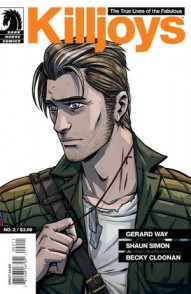 The first issue of The True Lives of the Fabulous Killjoys surprised us by successfully following up a concept album with an engaging story. The landscape, a potpourri of science fiction from Mad Max, Blade Runner and Hardware, is an intriguing one. In that first issue, Way and Simon spent much of the time setting up the environment, and that was just fine. However, this second issue is slightly less engaging, as Way appears to be spinning his wheels already, and spending more time wandering the landscape without purpose. The introduction of Cheri Cola gives us a little more of an idea of what the Killjoys were about and what they died fighting for, but there’s no real motivation here yet. The possible exception is the sub-plot of a pleasure model robot looking for a replacement battery for her companion, and there is genuine pathos in these sequences. Becky Cloonan does the heavy lifting here, with her art being the primary reason to pick up this book on a monthly basis. Once again, she straddles at least two worlds here, the stark wasteland that the characters principally inhabit, and the slate-grey bureaucracy of the secondary story. Her skill is in creating a consistent feel between the two distinct landscapes, so they all feel part of the same world. The series will be worth a third look next month, with the hope that it progresses the story elements slightly, although there’s an increased sense that we are just delaying the inevitable unveiling of some returning heroes.
The first issue of The True Lives of the Fabulous Killjoys surprised us by successfully following up a concept album with an engaging story. The landscape, a potpourri of science fiction from Mad Max, Blade Runner and Hardware, is an intriguing one. In that first issue, Way and Simon spent much of the time setting up the environment, and that was just fine. However, this second issue is slightly less engaging, as Way appears to be spinning his wheels already, and spending more time wandering the landscape without purpose. The introduction of Cheri Cola gives us a little more of an idea of what the Killjoys were about and what they died fighting for, but there’s no real motivation here yet. The possible exception is the sub-plot of a pleasure model robot looking for a replacement battery for her companion, and there is genuine pathos in these sequences. Becky Cloonan does the heavy lifting here, with her art being the primary reason to pick up this book on a monthly basis. Once again, she straddles at least two worlds here, the stark wasteland that the characters principally inhabit, and the slate-grey bureaucracy of the secondary story. Her skill is in creating a consistent feel between the two distinct landscapes, so they all feel part of the same world. The series will be worth a third look next month, with the hope that it progresses the story elements slightly, although there’s an increased sense that we are just delaying the inevitable unveiling of some returning heroes.
Agree or disagree? Got a comment? Start a conversation below, or take it with you on Behind the Panel’s Facebook and Twitter!
If you are an iTunes user, subscribe to our weekly podcast free here and please leave us feedback.

